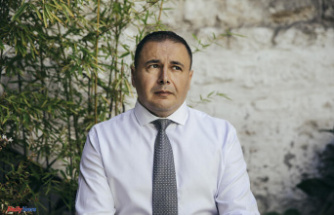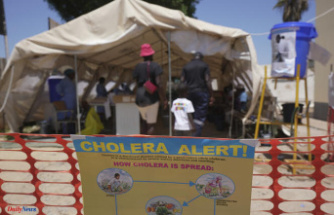In addition to acne, neurodermatitis and psoriasis, rosacea is one of the most common skin diseases. Most women are affected between the ages of 30 and 50, but the chronic inflammatory disease can occur earlier and also in men. A dermatologist explains what those affected can do.
Facial redness, visible veins, pustules: An estimated 10 percent of the European population is affected by the chronic inflammatory skin disease rosacea. The German term "facial rose" belies the high level of suffering that people with rosacea feel. Even if the face blushes spontaneously more often, you should prick up your ears. Because it can already be a preliminary stage of the skin disease.
Even if the disease is considered incurable, something can be done about it: "Although rosacea is often chronic and flare-ups, there are also symptom-free months. The skin disease is not completely curable, but can be easily regulated with the right treatment and lifestyle." says dermatologist Dr. Susanne Steinkraus in an interview with ntv.de.
Rosacea shows reddening of the face: "Initially reddening of the skin is visible, in the course vasodilatation as well as papules and pustules appear. The skin changes can be accompanied by burning and a feeling of tension," says Steinkraus. The sudden blush is also almost always accompanied by an uncomfortable feeling of warmth. In the final stage of the disease, the sebaceous glands and connective tissue can enlarge, resulting in bulbous growths. They appear mainly on the nose and almost exclusively affect men.
In 30 to 50 percent of those affected, the eyes are also affected (opthalmo-rosacea): "This is noticeable through dilated blood vessels in the eyes and dry and inflamed eyes," explains the dermatologist. In this case, those affected should also consult an ophthalmologist who is familiar with the treatment of ophthalmic rosacea. This is the only way to avoid serious complications that threaten your eyesight.
It is not yet clear why people develop rosacea. Several factors are probably involved: disorders in the immune system, an inflammatory reaction to hair follicle mites that colonize the facial skin, and a dysregulation of the nervous and vascular systems are discussed. "The genetic predisposition plays a role, because rosacea tends to run in families," says the dermatologist. Furthermore, hormonal changes, such as during pregnancy or menopause, can promote the development of rosacea. A cohort study in rosacea patients also demonstrated a changed intestinal environment, which was reflected in increased colonization by the intestinal germ Helicobacter pylori. In addition, those affected often had symptoms of irritable gastrointestinal syndrome.
Therefore, those affected can often improve their complexion with the right diet and prevent new rosacea flare-ups. The preventive medicine specialist Dr. In an interview with rtl.de, Anne Fleck recommends an anti-inflammatory diet. This can help to improve the complexion. The expert advises eliminating sweets, sugar, white flour products such as bread, white rice and soy products from the menu. Those affected should also avoid spicy foods and alcohol if possible. Both have a vasodilating effect and also promote redness. The consumption of red and processed meat also has an unfavorable effect on the complexion, as it promotes inflammation.
Whether the disease flares up also depends on the patient's ability to identify and avoid their personal triggers. "Trigger factors for rosacea are increased UV exposure, strong temperature fluctuations, hot baths, sauna sessions, caffeine and tea-containing drinks, spicy foods and stress," says Steinkraus.
Basically, it is important to consult a dermatologist if the redness persists. Depending on the stage of the disease, various therapy options are available for the treatment of rosacea. "In the case of milder forms of rosacea, topical therapy leads to an improvement in the appearance of the skin. In the case of more severe forms, systemic treatment is also required," says Steinkraus.
In topical treatment, antibiotics such as metronidazole, but also azealaic acid, ivermectin (against demodex mites) and retinoids are applied to the affected areas of the skin. They all have an anti-inflammatory effect. According to Steinkraus, brimonidine causes the dilated vessels in the facial skin to contract again. If the ointments are no longer sufficient, antibiotics are used in other forms. These include tetracyclines such as doxycycline. They have an anti-inflammatory effect against papules and pustules. The same applies to macrolides, which are used when tetracyclines are not tolerated. In very severe cases, off-label treatment with low-dose isotretinoin, which is approved for the treatment of severe acne, may also be an option. Permanent vascular dilatations and large areas of redness can also be treated with laser therapy. "Phyma (growths) can also be removed with another laser," adds Steinkraus.
Care with unsuitable ingredients can also lead to a deterioration in the complexion. "A skin care routine prescribed by a dermatologist and specially developed for sensitive rosacea skin is recommended in addition to topical and systemic care," she explains. Rosacea patients should use creams and lotions that have a high water content and are not too greasy. Otherwise the greasy film on the skin can clog the pores.
In addition, fragrances and dyes can irritate the sensitive rosacea skin. "Irritating and astringent active ingredients are unsuitable for patients with rosacea. Coarse-grain peelings should also be avoided, as they can also irritate the skin," explains the skin expert. Menthol, tannins, camphor, silver nitrate, sodium lauryl sulfate, and alums are other ingredients that are unsuitable. It is also important that the product used during the day contains a UV filter, as excessive exposure to the sun can lead to new flare-ups.
Despite the various treatment methods, many patients still suffer from the skin disease. A global online survey "Rosacea: Beyond the visible" (Burden) among 500 dermatologists and 700 rosacea patients revealed that the level of suffering in most of those affected is great despite therapy. 59 percent continue to suffer from symptoms and 87 percent continuously experience new flare-ups. There is therefore still a need for research into the effective treatment of rosacea.












